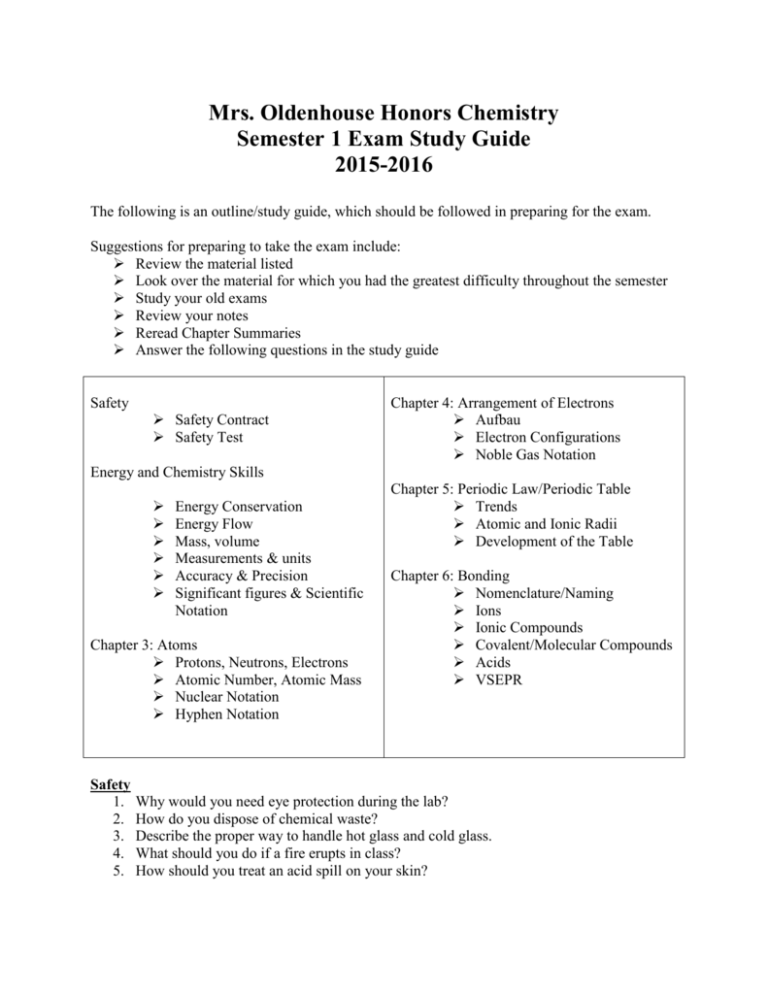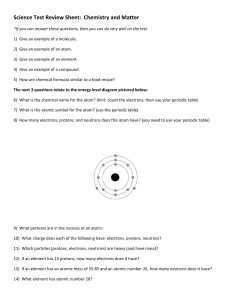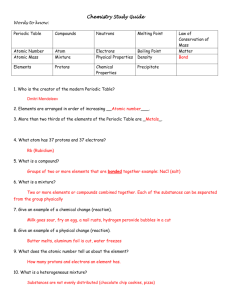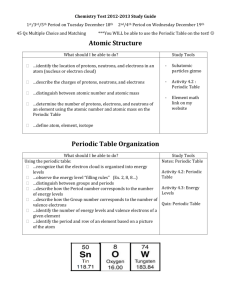File
advertisement

Mrs. Oldenhouse Honors Chemistry Semester 1 Exam Study Guide 2015-2016 The following is an outline/study guide, which should be followed in preparing for the exam. Suggestions for preparing to take the exam include: Review the material listed Look over the material for which you had the greatest difficulty throughout the semester Study your old exams Review your notes Reread Chapter Summaries Answer the following questions in the study guide Safety Safety Contract Safety Test Chapter 4: Arrangement of Electrons Aufbau Electron Configurations Noble Gas Notation Energy and Chemistry Skills Energy Conservation Energy Flow Mass, volume Measurements & units Accuracy & Precision Significant figures & Scientific Notation Chapter 3: Atoms Protons, Neutrons, Electrons Atomic Number, Atomic Mass Nuclear Notation Hyphen Notation Safety 1. 2. 3. 4. 5. Chapter 5: Periodic Law/Periodic Table Trends Atomic and Ionic Radii Development of the Table Chapter 6: Bonding Nomenclature/Naming Ions Ionic Compounds Covalent/Molecular Compounds Acids VSEPR Why would you need eye protection during the lab? How do you dispose of chemical waste? Describe the proper way to handle hot glass and cold glass. What should you do if a fire erupts in class? How should you treat an acid spill on your skin? Energy and Chemistry Skills 6. Define accuracy. Define precision. Compare and contrast accuracy and precision. 7. What is a hypothesis? 8. Why are experiments conducted? Hint: look up the definition. 9. Compare and constrast the dependent and independent variable. Where would these variables be graphed on the X and Y axis? 10. Give an example of chemical energy converting to kinetic energy. 11. Electrical energy, thermal energy, movement energy, and sound energy are all examples of what type of energy? 12. How can we increase the potential energy of an object? 13. What energy is stored in food? 14. What state of matter has the highest kinetic energy? 15. Draw an endothermic and exothermic energy diagram. Idenitfy the reactants, products and whether energy was absorbed or released in the appropriate diagram. 16. How does temperature relate to energy? Hint: See definition. 17. Describe the meaning of the equation KE = ½ MV2 18. What is the largest to smallest unit prefixes (commonly used in conversion practice)? 19. Be able to convert the following: a. 0.058 cm = ____________ mm = _____________ km b. 102,000 mg = ____________ g = _____________ kg c. 423.00 L = ____________ mL = _____________cm3 20. Write the following in scientific notation: a. 2.020100 m = ________________________ b. 0.000090 L = ________________________ c. 4000300.0 g = ________________________ 21. What are the rules for significant figures? a. According to rounding rules for addition, the sum of 27.1, 34.538, and 37.68 is ____. 22. The dimensions of a rectangular solid are measured to be 3.624 cm, 2.23 cm, and 2.5 cm. The volume should be recorded as ( v = l x w x h ) _____________. 23. How do you calculate molar mass? Calculate the molar mass for the following: a. H2O b. Ca(OH)2 c. 2 Al2(SO4)3 24. What is Avogadro’s number? Give a detailed answer. 25. Convert the following using dimensional analysis: a. 39.39 g = _______ atoms b. 50.15 g = _______ moles c. 3.5 mol = _______ g d. 3.01 x 1023 tin atoms (atomic mass 118.71 amu) = ____________ g 26. Naturally occurring element X exists in three isotopic forms: X-28 (27.977 amu, 92.23% abundance), X-29 (28.976 amu, 4.67% abundance), and X-30 (29.974 amu, 3.10% abundance). Calculate the atomic weight of X. Atoms 27. Describe the early theories of the atom along with the philospphers’ names. 28. Describe the postulates of Dalton’s atomic theory. Identify which postulates are no longer accepted as true. 29. What are the subatomic particles of the atom and where they are located? 30. What is the 3D region around the nucleus called? 31. Define the following: a. Law of Conservation of Mass b. Law of Multiple Proportions c. Law of Definite Proportions 32. Determine the protons, neutrons and electrons for: Protons Neutrons Electrons Oxygen atom Oxygen ion Neon Fluorine atom Fluorine ion Hydrogen 33. Fill in the blank: An atom becomes negatively charged by ________________________. 34. Write the nuclear notation and the hyphen notation for a species that has a. 48 protons, 66 neutrons, and 48 electrons b. 48 protons, 62 neutrons, and 46 electrons 35. What is the symbol for a species which contains 57 neutrons and has a mass number of 101? Arrangement of Electrons 36. Which of the following scientists first postulated that the sharp lines in the emission spectra of elements were caused by electrons going from high-energy levels to low-energy levels? 37. How does excited and ground state differ? 38. Which color, in visible light, has the: a. Highest b. Highest c. Longest frequency energy wavelength 39. Define the following: a. Wavelength d. Quantum b. Frequency e. Photon c. Velocity (speed) 40. Describe the following: a. Schrodinger’s wave equation b. Heisenberg’s uncertainty principle c. Aufbau priciple d. Pauli exclusion principle e. Hund’s rule 41. Write the electron configuration and the orbital diagram for the following elements: a. Iron b. Bromine c. Tungsten 42. Identify the 4 quantum numbers. What does each one mean? What are their possible values? 43. Which sets of quantum numbers (n, l, ml, ms) could be used to refer to a 3d orbital? 44. Which numbers could be a valid ml quantum number for a 4f orbital? 45. What are the shapes of s, p, d, and f orbitals? 46. What happens to the energy of an electron in Bohr's atomic theory, when an electron moves from one energy level to another energy level more distant from the nucleus? Periodic Law/Periodic Table 47. State the periodic law. 48. Describe the contributions (to the periodic table) from the following scientists: a. Newlands c. Mendeleev b. Meyer d. Mosley 49. Why did Mendeleev leave blank spaces on the periodic table? 50. Where are metals and nonmetals found on the periodic table? 51. Identify the locations (by group or periods) of the following: a. Noble gases g. Representative elements b. Halogens h. Transition elements c. Alkali metals i. Metalloids d. Alkaline earth metals j. Group A elements e. Lanthanide series k. Group B elements f. Actinide series 52. Define the following terms and describe their trend on the periodic table: a. Ionization energy b. Electronegativity c. Atomic radii d. Ionic radii Bonding 53. How are ionic and covalent bonds different? (Use electron movement to to complete this answer.) 54. How are ionic compounds different from molecules? (Describe the composition of each.) 55. How do you determine the central atom in a molecule? 56. Draw the Lewis structure for N2O. 57. Defiine a coordinate covalent bond. 58. Which elements are commonly found as diatomic molecules? 59. What is VSEPR? Why is it used? 60. Using VSEPR, determine the shape of CCl4. 61. Fill in the blank: As the number of bonds between 2 carbon atoms increases, the bond length ______________. 62. Write the fornula for the following compound/molecule: a. Tin (II) oxide e. Tetranitrogen hexafluoride b. Tin (IV) oxide f. Hydrophosphoric acid c. Tin (II) hydroxide g. Phosphoric acid d. Chlorine 63. Write the names for the following: a. MgF2 b. Ca3(PO4)2 c. O2 d. CH4 e. H2SO4







